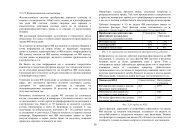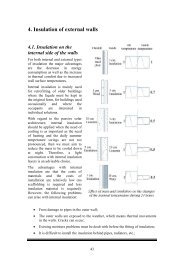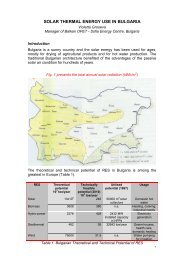Guidebook for Energy Efficiency in Municipalities
Guidebook for Energy Efficiency in Municipalities
Guidebook for Energy Efficiency in Municipalities
Create successful ePaper yourself
Turn your PDF publications into a flip-book with our unique Google optimized e-Paper software.
not clearly identifiable, try switch<strong>in</strong>g the power off and then on; the lamps may ‘strike’<br />
at different times so the number of lamps will be more obvious.<br />
If the floor area is difficult to measure because of obstructions, the ceil<strong>in</strong>g tiles could be<br />
counted. Each rectangular tile has an area of 0.74 m² and each square tile 0.37 m².<br />
Prospect<strong>in</strong>g <strong>for</strong> sav<strong>in</strong>gs <strong>in</strong> office light<strong>in</strong>g<br />
Beg<strong>in</strong> search<strong>in</strong>g <strong>for</strong> light<strong>in</strong>g energy sav<strong>in</strong>gs by check<strong>in</strong>g <strong>for</strong>:<br />
Old, dirty fluorescent lamps and fitt<strong>in</strong>gs: clean<strong>in</strong>g the fitt<strong>in</strong>g will help, and us<strong>in</strong>g<br />
new, efficient lamps will allow gett<strong>in</strong>g the same amount of light from fewer lamps.<br />
Fluorescent lamps dim as they age, so make sure the <strong>in</strong>itial illum<strong>in</strong>ance is sufficiently<br />
higher than the ma<strong>in</strong>tenance illum<strong>in</strong>ance, although the extra quantity required can be<br />
m<strong>in</strong>imised by us<strong>in</strong>g modern ‘through-life’ tri-phosphor lamps, which lose less than<br />
10% of their <strong>in</strong>itial light output over their rated life.<br />
Light<strong>in</strong>g levels significantly above those required: this is usually because the<br />
light<strong>in</strong>g has been designed assum<strong>in</strong>g the space will be used <strong>for</strong> office work when it is<br />
actually a walkway or staff room.<br />
Incandescent downlights: each 100W <strong>in</strong>candescent downlight uses more electricity<br />
than a 2 x 36 W fluorescent fitt<strong>in</strong>g, although it delivers about 80% less light. Also, the<br />
downlight hous<strong>in</strong>g causes the lamp to overheat, shorten<strong>in</strong>g the already short lamp life<br />
and add<strong>in</strong>g further to ma<strong>in</strong>tenance costs. Compact fluorescent downlights will reduce<br />
the power required by 70% and are available from €30 (plus <strong>in</strong>stallation). In a typical<br />
office, each <strong>in</strong>candescent down-light replaced will save €5 to €15 <strong>in</strong> electricity costs.<br />
Street light<strong>in</strong>g<br />
Electricity distribution companies normally and, to a lesser extent, state departments that<br />
adm<strong>in</strong>ister arterial roads provide street light<strong>in</strong>g (equipment, ma<strong>in</strong>tenance, and energy) on<br />
behalf of municipality. Of all municipal services, street light<strong>in</strong>g is the one that uses the<br />
most energy. It is also an expensive activity. Good street light<strong>in</strong>g has an important role to<br />
play <strong>in</strong> the community. It contributes to people’s quality of life by improv<strong>in</strong>g pedestrian<br />
and traffic safety, as well as mak<strong>in</strong>g people feel safer; it also improves the appearance of<br />
the local environment.<br />
A decade ago, the electricity <strong>in</strong>dustry consisted ma<strong>in</strong>ly of government monopolies, whose<br />
ma<strong>in</strong> concern was the <strong>in</strong>tegrity of the electricity supply system. Street light<strong>in</strong>g was a small<br />
additional task that accompanied the poles and wires asset, so it was not a high priority<br />
and the energy efficiency of the service was a small concern. Dur<strong>in</strong>g the 1990s, much of<br />
the electricity supply <strong>in</strong>dustry was divided <strong>in</strong>to smaller parts, as generators separated<br />
from distributors and energy retailers. For distributors street light<strong>in</strong>g is a bigger issue than<br />
it was to vertically <strong>in</strong>tegrated utilities. Street light<strong>in</strong>g accounts <strong>for</strong> about 20% of the GHG<br />
emissions attributable to a distribution company, so there is as well an environmental<br />
<strong>in</strong>centive to improve its energy efficiency.<br />
Opportunities <strong>for</strong> sav<strong>in</strong>gs<br />
An Australian <strong>in</strong>vestigation of street light<strong>in</strong>g from 1999 found that present street light<strong>in</strong>g<br />
systems are <strong>in</strong>efficient, <strong>in</strong> that the quality of illum<strong>in</strong>ation of both m<strong>in</strong>or and major roads is<br />
much lower than can be achieved, and the energy efficiency is low. Apart from that, there<br />
is a basic mismatch between the light colour produced by many streetlights and the light<br />
colour that the human eye can use under typical street light<strong>in</strong>g conditions.<br />
The study also found that the quality of street light<strong>in</strong>g could be significantly improved, and<br />
the energy consumption at least halved, by a comb<strong>in</strong>ation of:






